2015 NISSAN ROGUE SELECT transmission
[x] Cancel search: transmissionPage 298 of 322
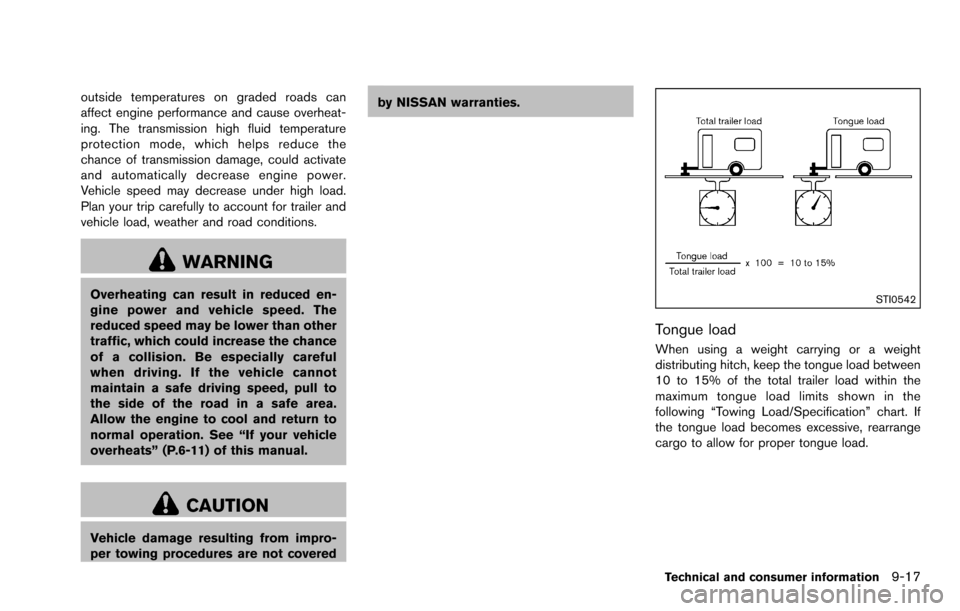
outside temperatures on graded roads can
affect engine performance and cause overheat-
ing. The transmission high fluid temperature
protection mode, which helps reduce the
chance of transmission damage, could activate
and automatically decrease engine power.
Vehicle speed may decrease under high load.
Plan your trip carefully to account for trailer and
vehicle load, weather and road conditions.
WARNING
Overheating can result in reduced en-
gine power and vehicle speed. The
reduced speed may be lower than other
traffic, which could increase the chance
of a collision. Be especially careful
when driving. If the vehicle cannot
maintain a safe driving speed, pull to
the side of the road in a safe area.
Allow the engine to cool and return to
normal operation. See “If your vehicle
overheats” (P.6-11) of this manual.
CAUTION
Vehicle damage resulting from impro-
per towing procedures are not coveredby NISSAN warranties.
STI0542
Tongue load
When using a weight carrying or a weight
distributing hitch, keep the tongue load between
10 to 15% of the total trailer load within the
maximum tongue load limits shown in the
following “Towing Load/Specification” chart. If
the tongue load becomes excessive, rearrange
cargo to allow for proper tongue load.
Technical and consumer information9-17
Page 303 of 322
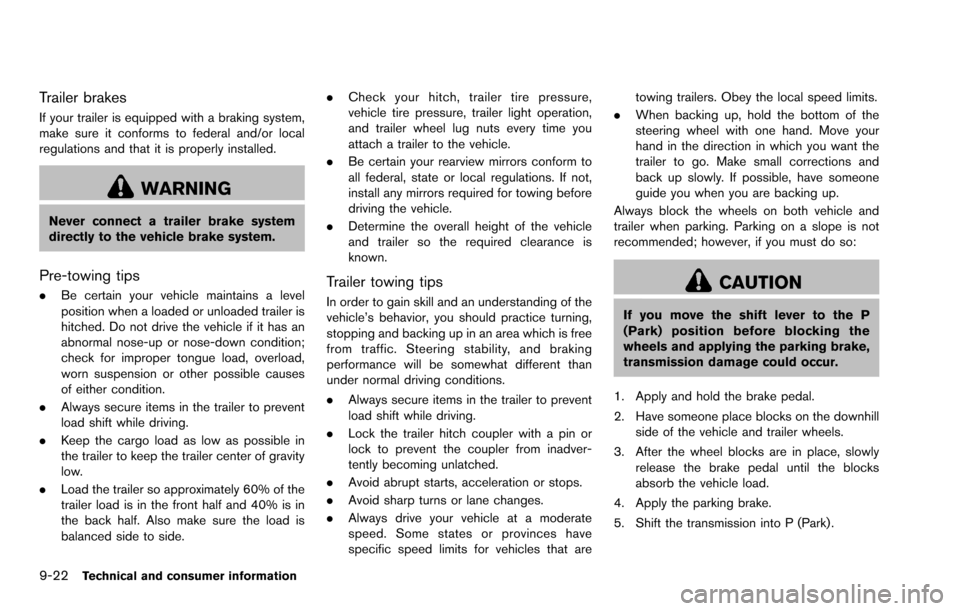
9-22Technical and consumer information
Trailer brakes
If your trailer is equipped with a braking system,
make sure it conforms to federal and/or local
regulations and that it is properly installed.
WARNING
Never connect a trailer brake system
directly to the vehicle brake system.
Pre-towing tips
.Be certain your vehicle maintains a level
position when a loaded or unloaded trailer is
hitched. Do not drive the vehicle if it has an
abnormal nose-up or nose-down condition;
check for improper tongue load, overload,
worn suspension or other possible causes
of either condition.
. Always secure items in the trailer to prevent
load shift while driving.
. Keep the cargo load as low as possible in
the trailer to keep the trailer center of gravity
low.
. Load the trailer so approximately 60% of the
trailer load is in the front half and 40% is in
the back half. Also make sure the load is
balanced side to side. .
Check your hitch, trailer tire pressure,
vehicle tire pressure, trailer light operation,
and trailer wheel lug nuts every time you
attach a trailer to the vehicle.
. Be certain your rearview mirrors conform to
all federal, state or local regulations. If not,
install any mirrors required for towing before
driving the vehicle.
. Determine the overall height of the vehicle
and trailer so the required clearance is
known.Trailer towing tips
In order to gain skill and an understanding of the
vehicle’s behavior, you should practice turning,
stopping and backing up in an area which is free
from traffic. Steering stability, and braking
performance will be somewhat different than
under normal driving conditions.
.Always secure items in the trailer to prevent
load shift while driving.
. Lock the trailer hitch coupler with a pin or
lock to prevent the coupler from inadver-
tently becoming unlatched.
. Avoid abrupt starts, acceleration or stops.
. Avoid sharp turns or lane changes.
. Always drive your vehicle at a moderate
speed. Some states or provinces have
specific speed limits for vehicles that are towing trailers. Obey the local speed limits.
. When backing up, hold the bottom of the
steering wheel with one hand. Move your
hand in the direction in which you want the
trailer to go. Make small corrections and
back up slowly. If possible, have someone
guide you when you are backing up.
Always block the wheels on both vehicle and
trailer when parking. Parking on a slope is not
recommended; however, if you must do so:
CAUTION
If you move the shift lever to the P
(Park) position before blocking the
wheels and applying the parking brake,
transmission damage could occur.
1. Apply and hold the brake pedal.
2. Have someone place blocks on the downhill side of the vehicle and trailer wheels.
3. After the wheel blocks are in place, slowly release the brake pedal until the blocks
absorb the vehicle load.
4. Apply the parking brake.
5. Shift the transmission into P (Park) .
Page 304 of 322
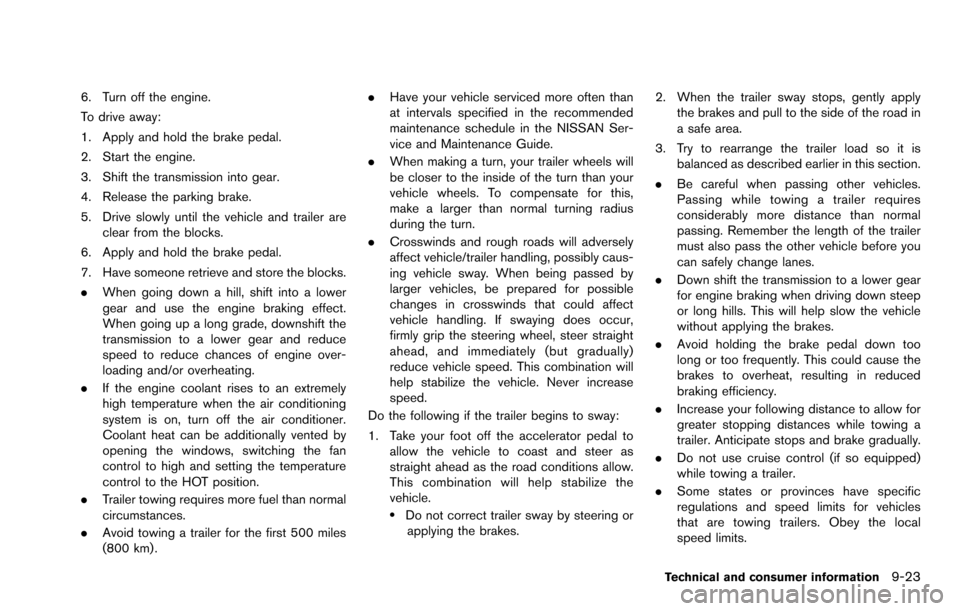
6. Turn off the engine.
To drive away:
1. Apply and hold the brake pedal.
2. Start the engine.
3. Shift the transmission into gear.
4. Release the parking brake.
5. Drive slowly until the vehicle and trailer areclear from the blocks.
6. Apply and hold the brake pedal.
7. Have someone retrieve and store the blocks.
. When going down a hill, shift into a lower
gear and use the engine braking effect.
When going up a long grade, downshift the
transmission to a lower gear and reduce
speed to reduce chances of engine over-
loading and/or overheating.
. If the engine coolant rises to an extremely
high temperature when the air conditioning
system is on, turn off the air conditioner.
Coolant heat can be additionally vented by
opening the windows, switching the fan
control to high and setting the temperature
control to the HOT position.
. Trailer towing requires more fuel than normal
circumstances.
. Avoid towing a trailer for the first 500 miles
(800 km) . .
Have your vehicle serviced more often than
at intervals specified in the recommended
maintenance schedule in the NISSAN Ser-
vice and Maintenance Guide.
. When making a turn, your trailer wheels will
be closer to the inside of the turn than your
vehicle wheels. To compensate for this,
make a larger than normal turning radius
during the turn.
. Crosswinds and rough roads will adversely
affect vehicle/trailer handling, possibly caus-
ing vehicle sway. When being passed by
larger vehicles, be prepared for possible
changes in crosswinds that could affect
vehicle handling. If swaying does occur,
firmly grip the steering wheel, steer straight
ahead, and immediately (but gradually)
reduce vehicle speed. This combination will
help stabilize the vehicle. Never increase
speed.
Do the following if the trailer begins to sway:
1. Take your foot off the accelerator pedal to allow the vehicle to coast and steer as
straight ahead as the road conditions allow.
This combination will help stabilize the
vehicle.
.Do not correct trailer sway by steering orapplying the brakes. 2. When the trailer sway stops, gently apply
the brakes and pull to the side of the road in
a safe area.
3. Try to rearrange the trailer load so it is balanced as described earlier in this section.
. Be careful when passing other vehicles.
Passing while towing a trailer requires
considerably more distance than normal
passing. Remember the length of the trailer
must also pass the other vehicle before you
can safely change lanes.
. Down shift the transmission to a lower gear
for engine braking when driving down steep
or long hills. This will help slow the vehicle
without applying the brakes.
. Avoid holding the brake pedal down too
long or too frequently. This could cause the
brakes to overheat, resulting in reduced
braking efficiency.
. Increase your following distance to allow for
greater stopping distances while towing a
trailer. Anticipate stops and brake gradually.
. Do not use cruise control (if so equipped)
while towing a trailer.
. Some states or provinces have specific
regulations and speed limits for vehicles
that are towing trailers. Obey the local
speed limits.
Technical and consumer information9-23
Page 305 of 322
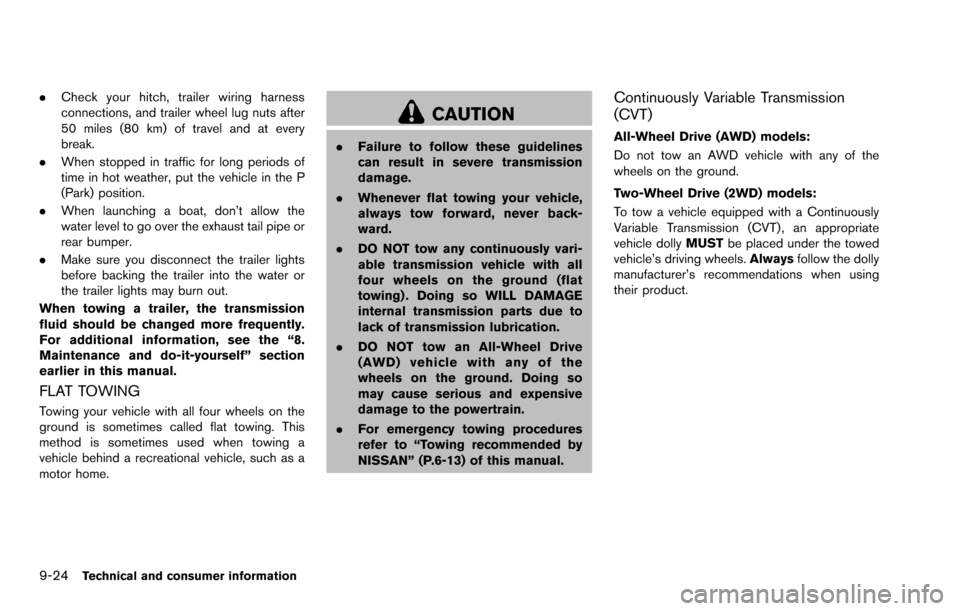
9-24Technical and consumer information
.Check your hitch, trailer wiring harness
connections, and trailer wheel lug nuts after
50 miles (80 km) of travel and at every
break.
. When stopped in traffic for long periods of
time in hot weather, put the vehicle in the P
(Park) position.
. When launching a boat, don’t allow the
water level to go over the exhaust tail pipe or
rear bumper.
. Make sure you disconnect the trailer lights
before backing the trailer into the water or
the trailer lights may burn out.
When towing a trailer, the transmission
fluid should be changed more frequently.
For additional information, see the “8.
Maintenance and do-it-yourself” section
earlier in this manual.
FLAT TOWING
Towing your vehicle with all four wheels on the
ground is sometimes called flat towing. This
method is sometimes used when towing a
vehicle behind a recreational vehicle, such as a
motor home.
CAUTION
. Failure to follow these guidelines
can result in severe transmission
damage.
. Whenever flat towing your vehicle,
always tow forward, never back-
ward.
. DO NOT tow any continuously vari-
able transmission vehicle with all
four wheels on the ground (flat
towing) . Doing so WILL DAMAGE
internal transmission parts due to
lack of transmission lubrication.
. DO NOT tow an All-Wheel Drive
(AWD) vehicle with any of the
wheels on the ground. Doing so
may cause serious and expensive
damage to the powertrain.
. For emergency towing procedures
refer to “Towing recommended by
NISSAN” (P.6-13) of this manual.
Continuously Variable Transmission
(CVT)
All-Wheel Drive (AWD) models:
Do not tow an AWD vehicle with any of the
wheels on the ground.
Two-Wheel Drive (2WD) models:
To tow a vehicle equipped with a Continuously
Variable Transmission (CVT) , an appropriate
vehicle dolly MUSTbe placed under the towed
vehicle’s driving wheels. Alwaysfollow the dolly
manufacturer’s recommendations when using
their product.
Page 307 of 322
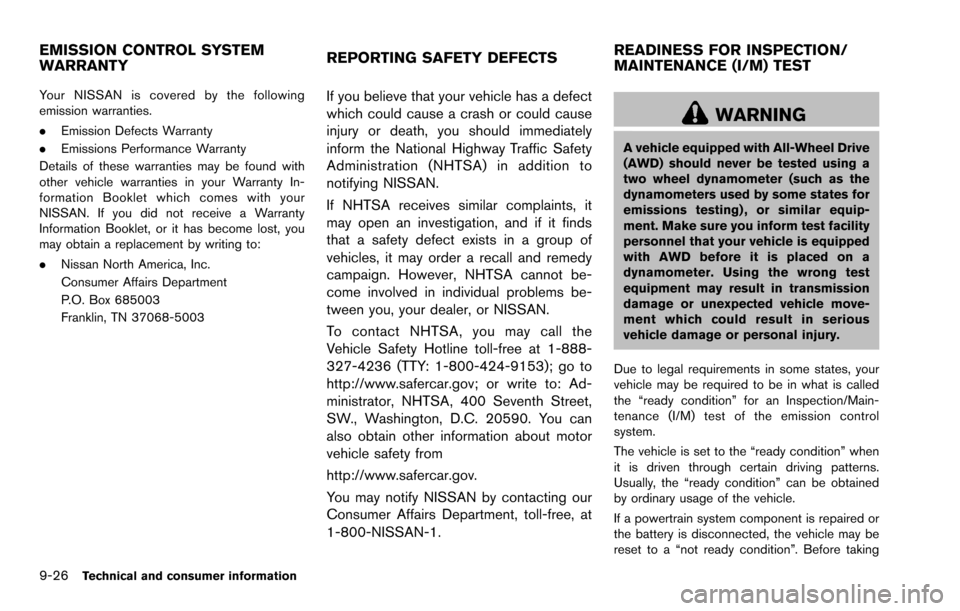
9-26Technical and consumer information
Your NISSAN is covered by the following
emission warranties.
.Emission Defects Warranty
. Emissions Performance Warranty
Details of these warranties may be found with
other vehicle warranties in your Warranty In-
formation Booklet which comes with your
NISSAN. If you did not receive a Warranty
Information Booklet, or it has become lost, you
may obtain a replacement by writing to:
. Nissan North America, Inc.
Consumer Affairs Department
P.O. Box 685003
Franklin, TN 37068-5003If you believe that your vehicle has a defect
which could cause a crash or could cause
injury or death, you should immediately
inform the National Highway Traffic Safety
Administration (NHTSA) in addition to
notifying NISSAN.
If NHTSA receives similar complaints, it
may open an investigation, and if it finds
that a safety defect exists in a group of
vehicles, it may order a recall and remedy
campaign. However, NHTSA cannot be-
come involved in individual problems be-
tween you, your dealer, or NISSAN.
To contact NHTSA, you may call the
Vehicle Safety Hotline toll-free at 1-888-
327-4236 (TTY: 1-800-424-9153); go to
http://www.safercar.gov; or write to: Ad-
ministrator, NHTSA, 400 Seventh Street,
SW., Washington, D.C. 20590. You can
also obtain other information about motor
vehicle safety from
http://www.safercar.gov.
You may notify NISSAN by contacting our
Consumer Affairs Department, toll-free, at
1-800-NISSAN-1.
WARNING
A vehicle equipped with All-Wheel Drive
(AWD) should never be tested using a
two wheel dynamometer (such as the
dynamometers used by some states for
emissions testing) , or similar equip-
ment. Make sure you inform test facility
personnel that your vehicle is equipped
with AWD before it is placed on a
dynamometer. Using the wrong test
equipment may result in transmission
damage or unexpected vehicle move-
ment which could result in serious
vehicle damage or personal injury.
Due to legal requirements in some states, your
vehicle may be required to be in what is called
the “ready condition” for an Inspection/Main-
tenance (I/M) test of the emission control
system.
The vehicle is set to the “ready condition” when
it is driven through certain driving patterns.
Usually, the “ready condition” can be obtained
by ordinary usage of the vehicle.
If a powertrain system component is repaired or
the battery is disconnected, the vehicle may be
reset to a “not ready condition”. Before taking
EMISSION CONTROL SYSTEM
WARRANTY REPORTING SAFETY DEFECTSREADINESS FOR INSPECTION/
MAINTENANCE (I/M) TEST
Page 312 of 322
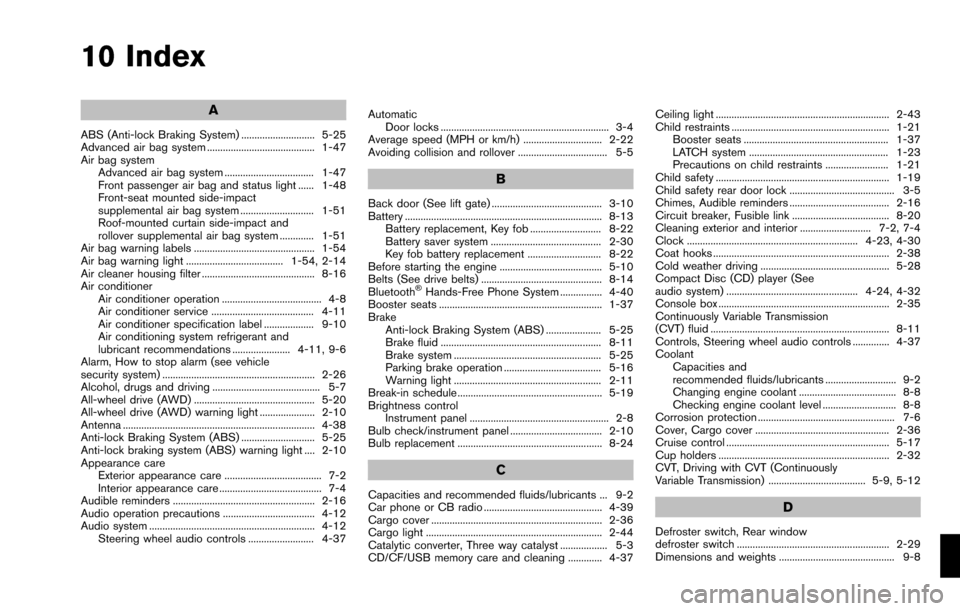
10 Index
A
ABS (Anti-lock Braking System) ............................ 5-25
Advanced air bag system ......................................... 1-47
Air bag systemAdvanced air bag system .................................. 1-47
Front passenger air bag and status light ...... 1-48
Front-seat mounted side-impact
supplemental air bag system ............................ 1-51
Roof-mounted curtain side-impact and
rollover supplemental air bag system ............. 1-51
Air bag warning labels .............................................. 1-54
Air bag warning light ..................................... 1-54, 2-14
Air cleaner housing filter ........................................... 8-16
Air conditioner Air conditioner operation ...................................... 4-8
Air conditioner service ....................................... 4-11
Air conditioner specification label ................... 9-10
Air conditioning system refrigerant and
lubricant recommendations ...................... 4-11, 9-6
Alarm, How to stop alarm (see vehicle
security system) .......................................................... 2-26
Alcohol, drugs and driving ......................................... 5-7
All-wheel drive (AWD) .............................................. 5-20
All-wheel drive (AWD) warning light ..................... 2-10
Antenna ......................................................................... 4-38
Anti-lock Braking System (ABS) ............................ 5-25
Anti-lock braking system (ABS) warning light .... 2-10
Appearance care Exterior appearance care ..................................... 7-2
Interior appearance care ....................................... 7-4
Audible reminders ...................................................... 2-16
Audio operation precautions ................................... 4-12
Audio system ............................................................... 4-12 Steering wheel audio controls ......................... 4-37 Automatic
Door locks ................................................................ 3-4
Average speed (MPH or km/h) .............................. 2-22
Avoiding collision and rollover .................................. 5-5
B
Back door (See lift gate) .......................................... 3-10
Battery ........................................................................... 8-13 Battery replacement, Key fob ........................... 8-22
Battery saver system .......................................... 2-30
Key fob battery replacement ............................ 8-22
Before starting the engine ....................................... 5-10
Belts (See drive belts) .............................................. 8-14
Bluetooth
�ŠHands-Free Phone System ................ 4-40
Booster seats .............................................................. 1-37
Brake Anti-lock Braking System (ABS) ..................... 5-25
Brake fluid ............................................................. 8-11
Brake system ........................................................ 5-25
Parking brake operation ..................................... 5-16
Warning light ........................................................ 2-11
Break-in schedule ....................................................... 5-19
Brightness control Instrument panel ..................................................... 2-8
Bulb check/instrument panel ................................... 2-10
Bulb replacement ....................................................... 8-24
C
Capacities and recommended fluids/lubricants ... 9-2
Car phone or CB radio ............................................. 4-39
Cargo cover ................................................................. 2-36
Cargo light ................................................................... 2-44
Catalytic converter, Three way catalyst .................. 5-3
CD/CF/USB memory care and cleaning ............. 4-37 Ceiling light .................................................................. 2-43
Child restraints ............................................................ 1-21
Booster seats ....................................................... 1-37
LATCH system ..................................................... 1-23
Precautions on child restraints ........................ 1-21
Child safety .................................................................. 1-19
Child safety rear door lock ........................................ 3-5
Chimes, Audible reminders ...................................... 2-16
Circuit breaker, Fusible link ..................................... 8-20
Cleaning exterior and interior ........................... 7-2, 7-4
Clock ................................................................. 4-23, 4-30
Coat hooks ................................................................... 2-38
Cold weather driving ................................................. 5-28
Compact Disc (CD) player (See
audio system) .................................................. 4-24, 4-32
Console box ................................................................. 2-35
Continuously Variable Transmission
(CVT) fluid .................................................................... 8-11
Controls, Steering wheel audio controls .............. 4-37
Coolant Capacities and
recommended fluids/lubricants ........................... 9-2
Changing engine coolant ..................................... 8-8
Checking engine coolant level ............................ 8-8
Corrosion protection .................................................... 7-6
Cover, Cargo cover ................................................... 2-36
Cruise control .............................................................. 5-17
Cup holders ................................................................. 2-32
CVT, Driving with CVT (Continuously
Variable Transmission) ..................................... 5-9, 5-12D
Defroster switch, Rear window
defroster switch .......................................................... 2-29
Dimensions and weights ............................................ 9-8
Page 313 of 322
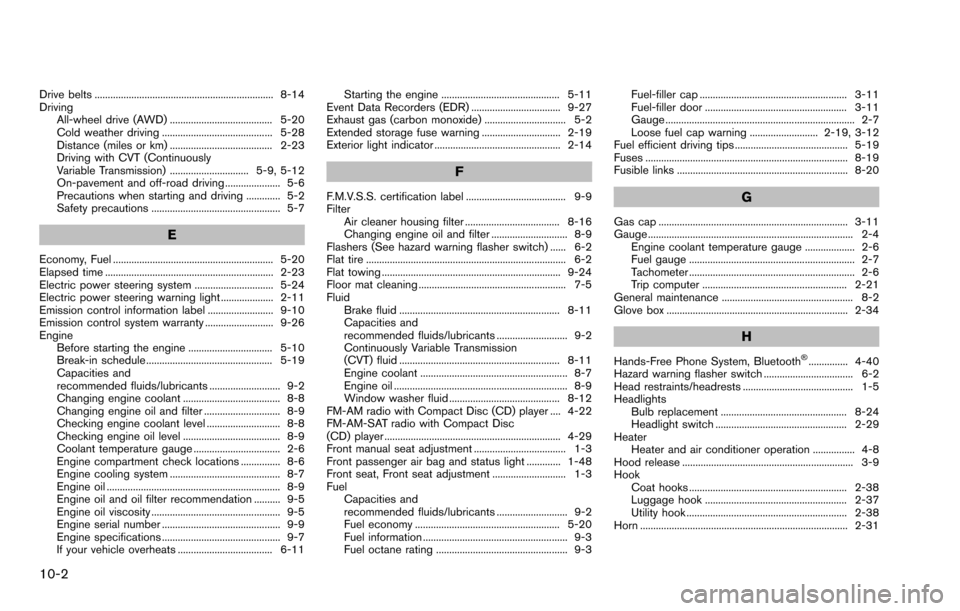
10-2
Drive belts .................................................................... 8-14
DrivingAll-wheel drive (AWD) ....................................... 5-20
Cold weather driving .......................................... 5-28
Distance (miles or km) ....................................... 2-23
Driving with CVT (Continuously
Variable Transmission) .............................. 5-9, 5-12
On-pavement and off-road driving ..................... 5-6
Precautions when starting and driving ............. 5-2
Safety precautions ................................................. 5-7
E
Economy, Fuel ............................................................. 5-20
Elapsed time ................................................................ 2-23
Electric power steering system .............................. 5-24
Electric power steering warning light .................... 2-11
Emission control information label ......................... 9-10
Emission control system warranty .......................... 9-26
EngineBefore starting the engine ................................ 5-10
Break-in schedule ................................................ 5-19
Capacities and
recommended fluids/lubricants ........................... 9-2
Changing engine coolant ..................................... 8-8
Changing engine oil and filter ............................. 8-9
Checking engine coolant level ............................ 8-8
Checking engine oil level ..................................... 8-9
Coolant temperature gauge ................................. 2-6
Engine compartment check locations ............... 8-6
Engine cooling system .......................................... 8-7
Engine oil .................................................................. 8-9
Engine oil and oil filter recommendation .......... 9-5
Engine oil viscosity ................................................. 9-5
Engine serial number ............................................. 9-9
Engine specifications ............................................. 9-7
If your vehicle overheats .................................... 6-11 Starting the engine ............................................. 5-11
Event Data Recorders (EDR) .................................. 9-27
Exhaust gas (carbon monoxide) ............................... 5-2
Extended storage fuse warning .............................. 2-19
Exterior light indicator ................................................ 2-14
F
F.M.V.S.S. certification label ...................................... 9-9
Filter Air cleaner housing filter .................................... 8-16
Changing engine oil and filter ............................. 8-9
Flashers (See hazard warning flasher switch) ...... 6-2
Flat tire ............................................................................ 6-2
Flat towing .................................................................... 9-24
Floor mat cleaning ........................................................ 7-5
Fluid Brake fluid ............................................................. 8-11
Capacities and
recommended fluids/lubricants ........................... 9-2
Continuously Variable Transmission
(CVT) fluid ............................................................. 8-11
Engine coolant ........................................................ 8-7
Engine oil .................................................................. 8-9
Window washer fluid .......................................... 8-12
FM-AM radio with Compact Disc (CD) player .... 4-22
FM-AM-SAT radio with Compact Disc
(CD) player ................................................................... 4-29
Front manual seat adjustment ................................... 1-3
Front passenger air bag and status light ............. 1-48
Front seat, Front seat adjustment ............................ 1-3
Fuel Capacities and
recommended fluids/lubricants ........................... 9-2
Fuel economy ....................................................... 5-20
Fuel information ....................................................... 9-3
Fuel octane rating .................................................. 9-3 Fuel-filler cap ........................................................ 3-11
Fuel-filler door ...................................................... 3-11
Gauge ........................................................................ 2-7
Loose fuel cap warning .......................... 2-19, 3-12
Fuel efficient driving tips ........................................... 5-19
Fuses ............................................................................. 8-19
Fusible links ................................................................. 8-20G
Gas cap ........................................................................ 3-11
Gauge .............................................................................. 2-4 Engine coolant temperature gauge ................... 2-6
Fuel gauge ............................................................... 2-7
Tachometer ............................................................... 2-6
Trip computer ....................................................... 2-21
General maintenance .................................................. 8-2
Glove box ..................................................................... 2-34
H
Hands-Free Phone System, Bluetooth�Š............... 4-40
Hazard warning flasher switch .................................. 6-2
Head restraints/headrests .......................................... 1-5
Headlights Bulb replacement ................................................ 8-24
Headlight switch .................................................. 2-29
Heater Heater and air conditioner operation ................ 4-8
Hood release ................................................................. 3-9
Hook Coat hooks ............................................................ 2-38
Luggage hook ...................................................... 2-37
Utility hook ............................................................. 2-38
Horn ............................................................................... 2-31
Page 315 of 322

10-4
Operation, Indicators for operation ........................ 2-19
Outside air temperature ............................................ 2-17
Outside mirrors ........................................................... 3-14
Overdrive OFF switch ............................................... 5-15
Overheat, If your vehicle overheats ....................... 6-11
Owner’s Manual/Service Manual
order information ......................................................... 9-28
P
Panic alarm .................................................................... 3-7
ParkingBrake break-in ...................................................... 5-25
Parking brake operation ..................................... 5-16
Parking on hills ..................................................... 5-23
Phone Bluetooth
�ŠHands-Free Phone System ......... 4-40
Car phone or CB radio ...................................... 4-39
Power Electric power steering system ....................... 5-24
Power door lock ..................................................... 3-3
Power outlet .......................................................... 2-31
Power windows .................................................... 2-39
Precautions Audio operation .................................................... 4-12
Braking precautions ............................................ 5-25
Child restraints ..................................................... 1-21
Cruise control ....................................................... 5-17
Driving safety ........................................................... 5-7
Maintenance ............................................................. 8-5
On-pavement and off-road driving ..................... 5-6
Seat belt usage ....................................................... 1-9
Supplemental restraint system ......................... 1-41
When starting and driving .................................... 5-2
Push starting ................................................................ 6-11
R
Radio ............................................................................. 4-12 Car phone or CB radio ...................................... 4-39
FM-AM radio with Compact Disc
(CD) player ............................................................ 4-22
Steering wheel audio controls ......................... 4-37
Range (distance to empty) ...................................... 2-23
Rapid air pressure loss ............................................... 5-6
Readiness for inspection/maintenance
(I/M) test ....................................................................... 9-26
Rear center seat belt ................................................. 1-15
Rear door lock, Child safety rear door lock .......... 3-5
Rear seats ...................................................................... 1-4
Rear window defroster switch ................................ 2-29
Rear window wiper and washer switch ............... 2-28
RearView Monitor ......................................................... 4-2
Recorders, Event data ............................................... 9-27
Registering your vehicle in another country .......... 9-8
Remote keyless entry system .................................... 3-5
Reporting safety defects .......................................... 9-26
Rollover ........................................................................... 5-5
Roof Roof rack ............................................................... 2-38
S
SafetyChild seat belts .................................................... 1-19
Towing safety ........................................................ 9-20
Satellite radio operation ............................................ 4-31
Seat adjustment Front manual seat adjustment ............................. 1-3
Front seats ............................................................... 1-3
Seat belt(s) Child safety ........................................................... 1-19
Infants ..................................................................... 1-20 Injured persons .................................................... 1-11
Larger children ..................................................... 1-20
Precautions on seat belt usage .......................... 1-9
Pregnant women .................................................. 1-11
Rear center seat belt .......................................... 1-15
Seat belt cleaning .................................................. 7-6
Seat belt extenders ............................................. 1-18
Seat belt hooks .................................................... 1-15
Seat belt maintenance ....................................... 1-18
Seat belt warning light ....................................... 2-13
Seat belts ................................................................. 1-9
Seat belts with pretensioners .......................... 1-52
Shoulder belt height adjustment ..................... 1-14
Small children ....................................................... 1-20
Three-point type .................................................. 1-11
Seat(s) Seats .......................................................................... 1-2
Security system (NISSAN Vehicle Immobilizer
System) , Engine start ................................................ 2-26
Security system, Vehicle security system ............. 2-24
Servicing air conditioner ........................................... 4-11
Settings ......................................................................... 2-23
Shift lever, Shift lock release ................................... 5-16
Shift lock release Transmission ......................................................... 5-16
Shifting CVT (Continuously
Variable Transmission) .............................. 5-9, 5-12
Shoulder belt height adjustment ............................ 1-14
Spare tire ............................................................. 8-38, 9-7
Spark plugs .................................................................. 8-15
Sport mode switch ..................................................... 5-14
Starting Before starting the engine ................................ 5-10
Jump starting ........................................................... 6-9
Precautions when starting and driving ............. 5-2
Push starting ......................................................... 6-11